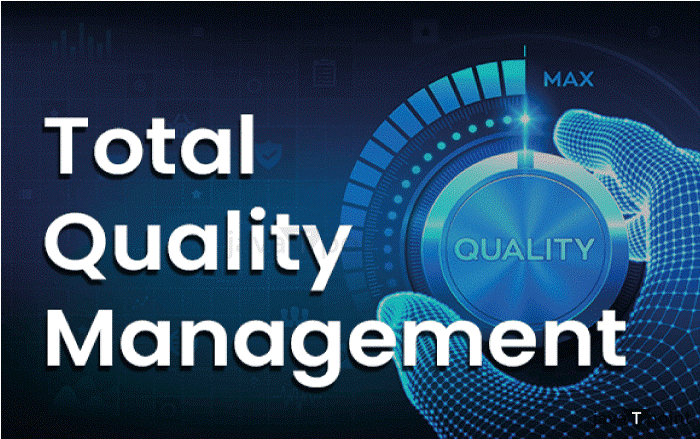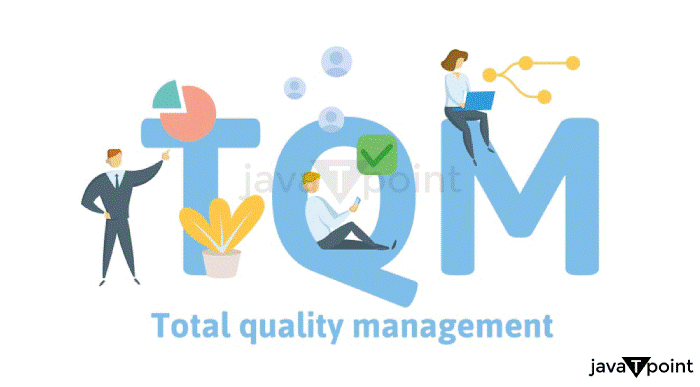TQM DefinitionTotal Quality Management (TQM) is a management strategy involving every organization's employees in improving the quality of processes, services, and goods. The basic objectives of TQM are to constantly raise output quality, increase customer happiness, and lower waste and expenses. 
TQM is a business conducting method that prioritizes quality and client happiness. It requires all employees, from top management to front-line staff, to collaborate to recognize and fix issues impacting the quality of the goods or services. The concepts of TQM include leadership participation, cooperation, employee empowerment, and continual improvement. These concepts may significantly increase organizations' quality, productivity, and profitability. Participation in TQM is open to all departments involved in producing a good or service, including the design, engineering, and marketing teams. Management serves as a facilitator by defining goals, providing competent people, and investing in their training. Continuous improvement refers to a company's ongoing efforts to find and fix issues with its procedures in order to raise the standard of its products. When an organization is focused on its customers, it is dedicated to surpassing their expectations. Employees that work well together can address issues and enhance procedures. Giving workers the power and tools to make decisions that influence quality is referred to as empowering employees. Top management's engagement in creating the organization's quality goals and tracking progress towards those goals is referred to as leadership involvement. History Of Study Of TQMTotal Quality Management (TQM) is a management strategy that works with every person in the company to continuously raise the caliber of goods and services. TQM research has a lengthy and fascinating past that extends back to the early 20th century. Statistical process control (SPC), regarded as the cornerstone of TQM, was created in the 1920s by a statistician named Walter Shewhart. By gathering information on a process's performance over time, SPC is a technique for monitoring and regulating it. Shewhart's ideas were later improved by W. Edwards Deming, who created the Deming Cycle, often known as PDCA (Plan-Do-Check-Act), which is a framework for ongoing improvement. TQM became well-known in Japan throughout the 1950s thanks to the efforts of Dr. Joseph Juran and Kaoru Ishikawa. Quality Planning, Quality Control, and Quality Improvement make up Juran's famed Quality Trilogy. On the other side, Ishikawa is renowned for creating the Ishikawa diagram, sometimes known as the fishbone diagram, which is a technique used to pinpoint a problem's main cause. TQM was widely embraced in the United States throughout the 1980s, and many businesses started applying its tenets to their daily operations. The ISO 9000 standard was created by the International Organization for Standardization (ISO) in 1987 and is a collection of quality management standards that businesses may apply to guarantee that their goods and services satisfy customers' needs. TQM is still a crucial topic of research for business executives and academics today. TQM is a subject taught in many colleges, and businesses worldwide use its ideas to enhance customer satisfaction and operational efficiency. "Although no official source has yet been identified, it is generally agreed that TQM emerged in the middle of the 1920s when Walter Shewhart developed a statistical sampling approach for quality control, which became known as Statistical Process Control (SPC). However, it wasn't until the 1980s that the phrase "total quality management" became popular." Why Is There a Need For TQM?An effective management strategy that may benefit both people and organizations is total quality management (TQM). TQM strongly emphasizes quality management and continuous development, which may assist in establishing an excellent culture that is advantageous to the organization's clients and employees. TQM has the advantage of assisting in the identification of skill shortages in personnel, which may then be filled through specialized training, education, or mentorship. Organizations may enhance the capabilities of their staff and foster career progression by emphasizing employee development, which will raise job satisfaction and retention rates. TQM's emphasis on cooperation and collaboration provides further advantages. Cross-functional teams that collaborate to solve issues and enhance procedures are encouraged by TQM. Every industry needs total quality control since whether a company is little or large, the caliber of its work is vitally important to both. Every business aspires to give its best to the client in order to gain recognition for the good it produces. This is what led to the TQM's requirement. In addition, quality is the only factor that matters, making it impossible for a product to compete in today's world of globalization and competition. Key Principles of TQMA culture of quality and efficiency is ingrained in an organization's operations via the use of Total Quality Management (TQM), which offers a set of tactics for achieving continual improvement. In order to design, monitor, and measure the performance of organizational processes and utilize that data to drive changes in goods and services, TQM emphasizes the need to leverage data and effective communication. TQM emphasizes the need to incorporate all personnel and divisions in ongoing development. Organizations may achieve this by creating a culture of responsibility and cooperation that encourages the constant pursuit of excellence. Organizations may develop a work atmosphere that fosters quality, collaboration, and innovation by adhering to these principles and applying TQM procedures. This will boost customer satisfaction and organizational success. The eight TQM guiding principles to enhance quality are the focus on customer demands, continuous improvement, employee participation, process-centered approach, data-driven decision-making, integrated system approach, leadership, and supplier relationships. Six Sigma and TQMTQM and Six Sigma are similar in that both techniques often involve all areas of the company in order to get the greatest outcomes for consumers. Six Sigma aims to preserve quality by lowering variance in manufacturing processes and eliminating faults, whereas Total Quality Management emphasizes the necessity of enhancing quality through process optimization. Six Sigma can be seen as a more advanced, scientific method of implementing Total Quality Management in businesses. Tools and Techniques for TQMThe management can utilize the TQM tools listed below for total quality management.
Armand V. Feigenbaum's "3 Principles of Total Quality Management"Feigenbaum established the idea of company-wide quality control (CWQC) in Total Quality Control, which some experts believe had the most significant influence on TQM. His three-step method to enhancing quality may be one of the first concepts that spring to mind when considering the three comprehensive quality management principles:
SafetyCulture to Implement Total Quality ManagementIt can be difficult to implement Total Quality Management within your organisation, especially given that it looks to have an incredibly broad reach. Businesses can streamline their TQM adoption with the aid of a digital operations management platform or tacking tools like SafetyCulture (formerly iAuditor). With SafetyCulture, staff employees may apply Total Quality Management to every part of business operations by:

ConclusionEvery organization must have TQM since it improves the project and helps save time and resources. Although TQM metrics might vary in every organization, achieving the highest quality is always the goal. As time passes and we get more contemporary, this parameter likewise experiences technical modifications. The market has seen the introduction of a lot of new software, which makes it simple to analyze this parameter at a very fine scale. By that time, TQM will always be implemented in businesses, and modifications should be made to recruiting and training practices to ensure that workers learn these fundamental concepts as soon as they begin their training and get off to a good start. Long-term benefits of this strategy for the business.
Next TopicTrade Union Definition
|
 For Videos Join Our Youtube Channel: Join Now
For Videos Join Our Youtube Channel: Join Now
Feedback
- Send your Feedback to [email protected]
Help Others, Please Share










